I hope you’re not sick of Gaudi yet because I still want to tell you about Guell Palace, Casa Batlló and Casa Mila, also known as La Pedrera, all three of which are on the Unesco World Heritage list. You’ve already seen the chimneys which I think are probably the most exciting part, but there are lots of other very interesting features as well. We visited the houses in the order in which they were built, as I thought it would be interesting to see the progression.
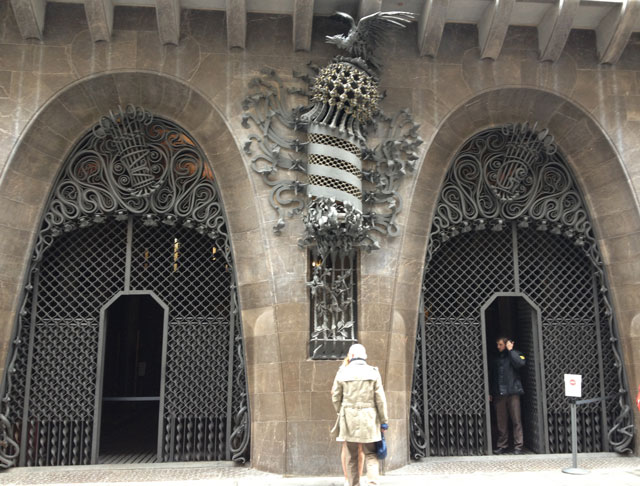
Personally, if I didn’t have time to see all the houses, I would give perference to Casa Batlló, then Guell Palace but I have friends who liked La Pedrera best. The entrance fees range from 12 euro per person including a very good audioguide for Guell Palace, 20.35 euro each with a good audioguide for Casa Batlló and 16.50 euro each with a terrible audioguide for La Pedrera.
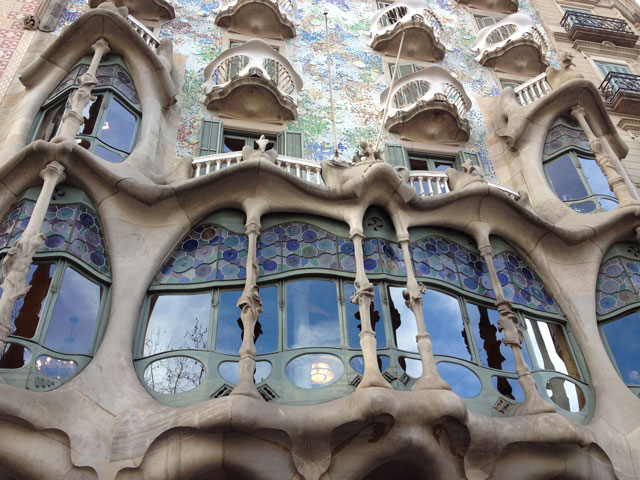
The queues were not very long, but I imagine it’s very different in the summer. You can book on-line at the following websites: Casa Bottló: http://www.casabatllo.es/en/buy-ticket/general-ticket/, payment by credit card or Paypal and La Pedrera: http://www.lapedrera.com/en/buy-your-ticket. I couldn’t find any sign of on-line bookings for Guell Palace.
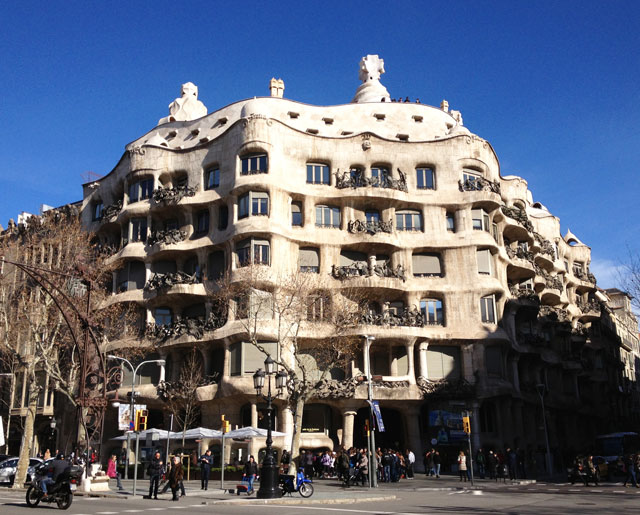
I thought I’d start with a comparison of the façades and describes the interiors in a subsquent post. Guell palace was built between 1885 and 1890. When construction began, Eusebi Guell, a rich textile manufacturer with a solid background in economics, law, science and the humanities, was 39 and Gaudi was only 34 and keen to break with tradition, with the unmitigated support of Guell. You may remember that Gaudi took on the Sagrada Familia in 1883 at the age of 31.
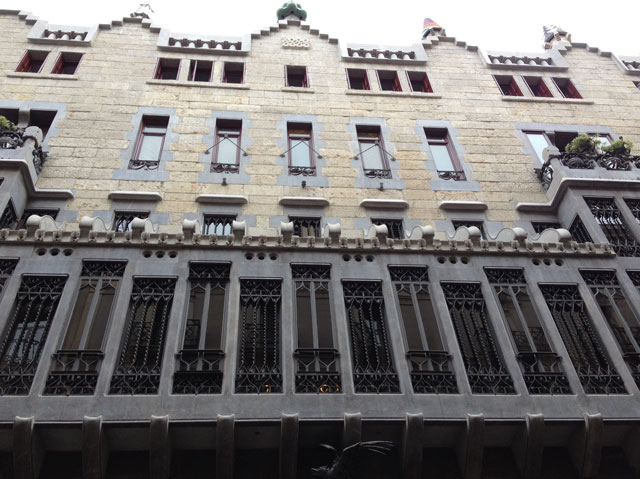
The façade is quite austere compared with the other houses. It has unusal parabolic arches with intricate wrought-iron work in the middle topped by a Venetian style tribune with leadlight windows. The rest of the façade is made of stone.
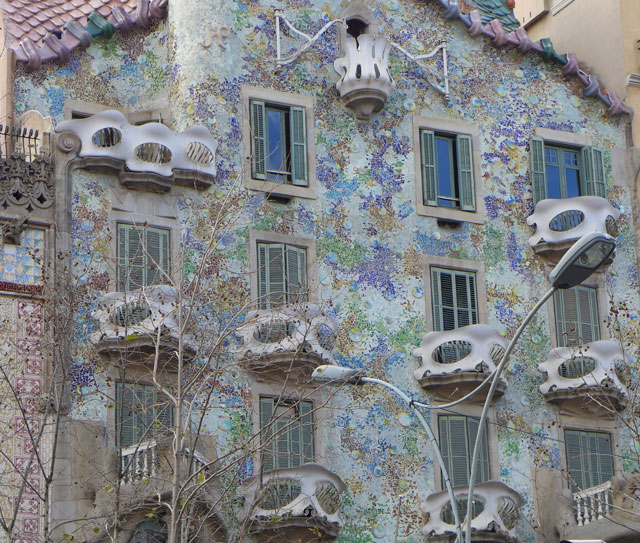
Nothing could be more different than the façade of Casa Batlló. It is located on Passeig de Gracia, a favourite promenade with the local bourgeois families. The house was 20 years old when Josep Battló bought it in 1903. He thought it looked somewhat dull next to its neighbour, Amatller, so he decided to call in Gaudi who, at 52, was at the height of his popularity, having started work on Guell Park in 1900.
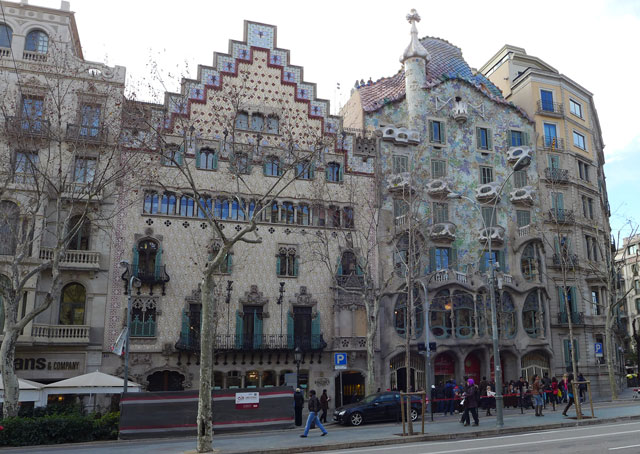
Gaudi kept the original structure and added two additional levels; the façade was a complete remake and is covered in the most wonderful mosaic work, along with other highly original details such as wavy walls, mask-shaped balconies, bone-like pillars, giving it the nickname of “Casa dels ossos” or the “House of Bones” and enlarged windows, for which it was dubbed “Casa Dels badall”s or the” House of Yawns”. The roof is shaped like the back of a dragon.
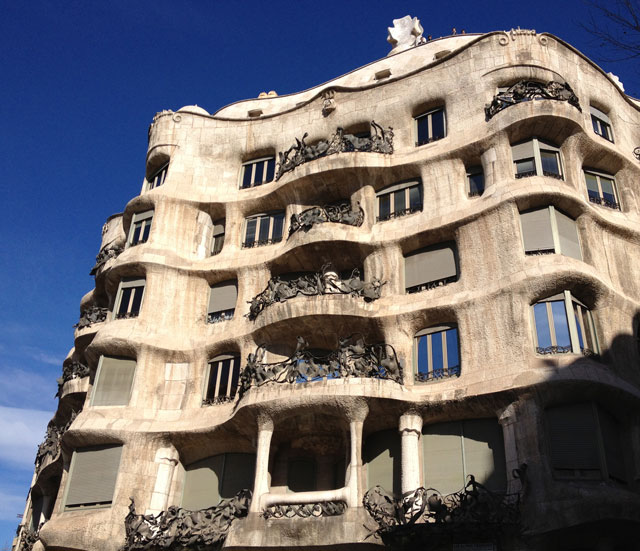
In 1905, Père Milà and Roser Segimon, a rich widow, decided to invest her fortune in a large piece of land further down the same street and commissioned Gaudi to build a six-storey apartment building of which they would occupy the 1,300 sq.m. main floor. There was a lot of friction between the architect and the promoters who didn’t appreciate having to pay out more and more money for bold decorative effects and construction principles that were strongly criticised by the press.
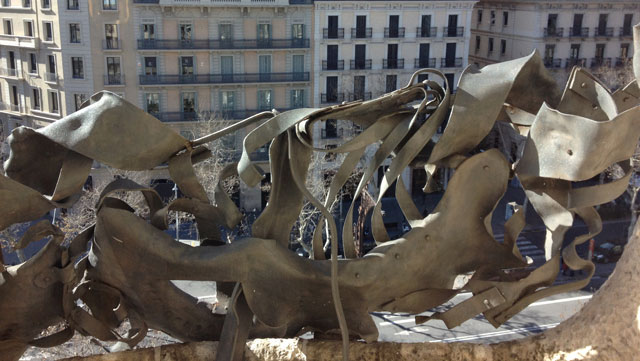
Its nickname of La Pedrera, which means “quarry” in Catalan, is due to its three cream-coloured stone façades which change colour as the light waxes and wanes. With their wavy lines, extravagant wrought-iron balconies and 150 windows, the overall effect is like billowing waves.
Guell Palace: open Tuesday to Sunday, 10 am to 8 pm in summer (April 1st to October 31st), 10 am to 5.40 pm in winter (November 1st to March 31st). Free on the first Sunday of every month, April 23, May 18th and September 24th. There are limited free tickets so check the website. Closed Mondays, except holidays, 25th and 26th December, 1st January and 6th to 13th January. Casa Battlo: open Monday to Sunday, 9 am to 9 pm, all year round. La Pedrera: open Monday to Sunday, 9 am to 8 pm in Summer (1st March to 4th November), 9 am to 6.30 pm in winter (5th November to 28th February), 11 am to 6.30 pm on 1st January. Closed 25th December and 7th to 13th January.



Thank you for your advice right before I left!
We were only there for two days and had two teenage girls with us, so we didn’t do the inside of the houses, but we saw the outside of Palau Guell and Casa Batllo. There, we were very lucky to stand right next to a group on a Gaudi tour, with an interesting and funny guide who had a weird Scottish/Spanish accent. We also saw Sagrada Familia (only the outside for lack of time) and Guell Park. On the other day, we visited Barrio Gotico, did some shopping (teenage girls, remember *g*) and ate tapas at the restaurant you recommended on Plaça Nova (btw, there is another one of the the same chain near Metro Jaume I – really good value for money). Then, we came across several parades (apparently for Santa Eulalia). I am lucky enough to live only a 4 hour drive away and to know someone who has an apartment in Barcelona, so I will certainly go back and see the museums and the inside of Gaudi’s buildings. What a wonderful city!
It’s great to be 4 hours’ drive away! I didn’t realise the tapas restaurant was part of a chain. Glad you enjoyed it. Hope you had nice weather.
Thank you for sharing these buildings with us. They are truly extraordinary.
The photos are wonderful but I can imagine how breathtaking they would be to see in real life. Gaudi was certainly someone who thought well outside the box. He must have been a challenge for his engineers and builders with those buildings.
Yes, I imagine that the engineers and builders must have loved him!
They really are fantastic buildings — in every sense of the word. Your photos are great, and make me want to go there.
Definitely recommend it!
Maybe it’s not a chain and they just have two locations in Barcelona. 🙂
What we loved is Gaudi’s attention to detail. To think that he moulded his statue’s faces and bodies on inhabitants of Barcelona… so impressive. Did you see the two statues on the Passion façade of Sagrada Familia that look like Darth Vader? I’ve been googling a bit in order to find out whether they were inspired by Darth Vader or if Darth Vader was inspired by them, but the websites contradict each other.
I’ve tweeted your question in the hope of finding an answer. I didn’t notice the Darth Vader ressemblance.
The photos are wonderful but I can imagine how breathtaking they would be to see in real life. Gaudi was certainly someone who thought well outside the box. He must have been a challenge for his engineers and builders with those buildings.